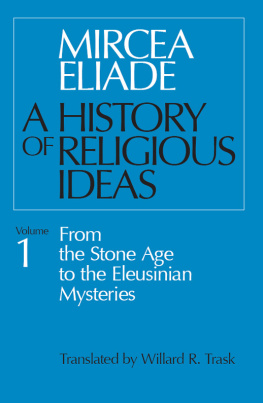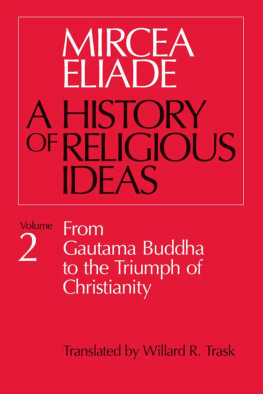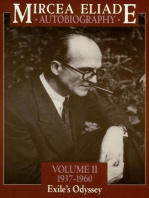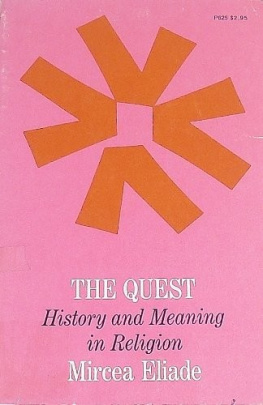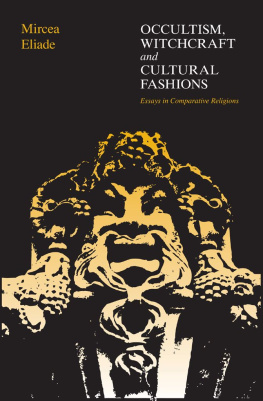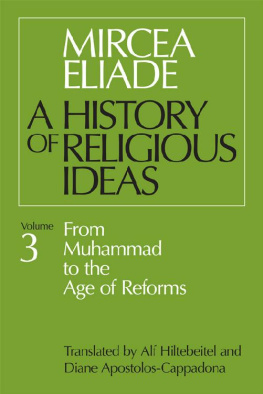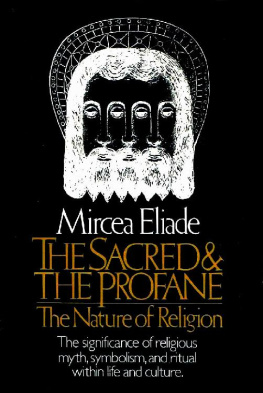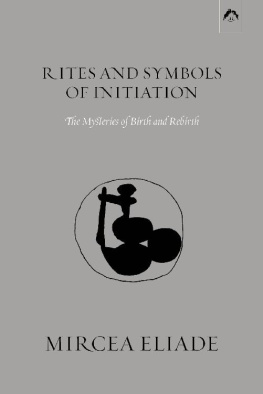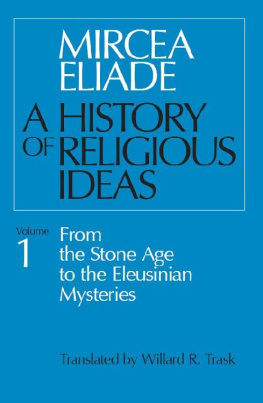Translated from the French by Willard R. Trask
MIRCEA ELIADE
A HISTORY OF RELIGIOUS IDEAS
VOLUME
1 | From the Stone Age to the Eleusinian Mysteries |
The University of Chicago Press
The University of Chicago Press, Chicago 60637
1978 by The University of Chicago
All rights reserved. Published 1978
Paperback edition 1981
Printed in the United States of America
09 08 07 06 05 04 11 12 13 14
ISBN-13: 978-0-226-14769-7 (e-book)
Library of Congress Cataloging in Publication Data
Eliade, Mircea, 1907
A History of religious ideas.
Translation of Histoire des croyances et des ides religieuses.
CONTENTS: 1. From the stone age to the Eleusinian mysteries.
1. ReligionHistory. 2. ReligionsHistory.
I. Title.
BL48.E3813 291 77-16784
ISBN 0-226-20400-6 (cloth)
ISBN 0-226-20401-4 (paper)
Originally published in French under the title Histoire des croyances et des ides religieuses. Vol. 1: De lge de la pierre aux mystres dleusis. Payot, Paris, 1976.
This book is printed on acid-free paper.
For Christinel
Contents
For the historian of religions, every manifestation of the sacred is important: every rite, every myth, every belief or divine figure reflects the experience of the sacred and hence implies the notions of being, of meaning, and of truth. As I observed on another occasion, it is difficult to imagine how the human mind could function without the conviction that there is something irreducibly real in the world; and it is impossible to imagine how consciousness could appear without conferring a meaning on mans impulses and experiences. Consciousness of a real and meaningful world is intimately connected with the discovery of the sacred. Through experience of the sacred, the human mind has perceived the difference between what reveals itself as being real, powerful, rich, and meaningful and what lacks these qualities, that is, the chaotic and dangerous flux of things, their fortuitous and senseless appearances and disappearances (preface to The Quest: History and Meaning in Religion [1969]). In short, the sacred is an element in the structure of consciousness and not a stage in the history of consciousness. On the most archaic levels of culture, living, considered as being human, is in itself a religious act, for food-getting, sexual life, and work have a sacramental value. In other words, to beor, rather, to becomea man signifies being religious (ibid.).
I have discussed the dialectic of the sacred and its morphology in earlier publications, from my Patterns in Comparative Religion (1958) to my little book devoted to Australian religions (Australian Religions: An Introduction [1973]). The present work was conceived and executed from a different point of view. On the one hand, I have analyzed the manifestations of the sacred in chronological order (but it is important not to confuse the age of a religious conception with the date of the earliest document that attests to it!); on the other handand insofar as the documentation makes it possibleI have emphasized the crises in depth and, above all, the creative moments of the different traditions. In short, I have attempted to elucidate the major contributions to the history of religious ideas and beliefs.
Every manifestation of the sacred is important to the historian of religions; but it is no less obvious that the structure of the god Anu, for example, or the theogony and cosmogony handed down in the Enuma elish, or the saga of Gilgamesh, reveal the religious creativity and originality of the Mesopotamians more effectively than, let us say, the apotropaic rites against Lamashtu or the mythology of the god Nusku. Sometimes the importance of a religious creation is revealed by its later valorizations. Very little is known about the Eleusinian Mysteries and the earliest manifestations of Orphism; yet the fascination that they have exercised over the best minds of Europe for more than twenty centuries constitutes a religious fact that is highly significant and whose consequences have not yet been properly understood. Certainly, the Eleusinian initiation and the secret Orphic rites, extolled by certain late authors, reflect mythologizing Gnosticism and Greco-Oriental syncretism. But it is precisely this conception of the Mysteries and of Orphism that influenced medieval Hermeticism, the Italian Renaissance, the occultist traditions of the eighteenth century, and Romanticism; and the Mysteries and the Orpheus that inspired modern European poetry, from Rilke to T. S. Eliot and Pierre Emmanuel, are still the Mysteries and the Orpheus of the scholars and mystics and theologians of Alexandria.
The validity of the criterion chosen to define the great contributions to the history of religious ideas is, of course, open to discussion. Yet the development of many religions confirms it; for it is because of crises in depth and the creations that result from them that religious traditions are able to renew themselves. It is enough to cite the case of India, where the tension and despair brought on by the religious devalorization of the Brahmanic sacrifice produced a series of outstanding creations (the Upanishads, the codification of Yogic techniques, the message of Gautama Buddha, mystical devotion, etc.), each one of them constituting a different and daring resolution of the same crisis (see chapters 9, 17, 18, and 19).
For years I have had in mind a short, concise work, which could be read in a few days. For continuous reading reveals above all the fundamental unity of religious phenomena and at the same time the inexhaustible newness of their expressions. The reader of such a book would be given access to the Vedic hymns, the Brhmaas, and the Upanishads a few hours after he had reviewed the ideas and beliefs of the Paleolithics, of Mesopotamia, and of Egypt; he would discover Sankara, Tantrism and Milarepa, Islam, Gioacchino da Fiore or Paracelsus, the day after he had meditated on Zarathustra, Gautama Buddha, and Taoism, on the Hellenistic Mysteries, the rise of Christianity, Gnosticism, alchemy, or the mythology of the Grail; he would encounter the German illuminists and Romantics, Hegel, Max Mller, Freud, Jung, and Bonhoeffer, soon after discovering Quetzalcoatl and Viracocha, the twelve Alvrs and Gregory Palamas, the earliest Cabalists, Avicenna or Eisai.
Alas, that short, concise book has not yet been written. For the moment, I have resigned myself to presenting a work in three volumes, in the hope of eventually reducing it to one volume of some 400 pages. I have chosen this compromise formula for two reasons in particular: on the one hand, I considered it advisable to quote a certain number of texts that are both important and insufficiently known; on the other hand, I wanted to provide the student with comparatively full critical bibliographies. So I have reduced footnotes to the text to the absolute minimum and have brought together, in a separate section, the bibliographies and the discussion of certain matters either not referred to at all or treated too summarily in the text. Hence the work can be read continuously, without the interruptions necessitated by discussions of sources and summaries of the present position of studies on particular points. Books presenting a general view of a subject and intended for an audience of other than specialists usually provide a list of titles at the end of each chapter. The structure of this History of Religious Ideas demanded a more complex critical apparatus. So I have divided the chapters into numbered sections, each with its own title. The student can thus easily consult the bibliographies and the summaries of the present position of studies in the second part of the book as he pursues his reading of the text. For each section I have tried to provide the essential recent critical bibliography, not omitting works whose methodological orientation I do not share. With very few exceptions, I have not mentioned contributions published in the Scandinavian, Slavic, or Balkan languages. To facilitate reading, I have simplified the transliteration of Oriental terms and proper names.
Next page
